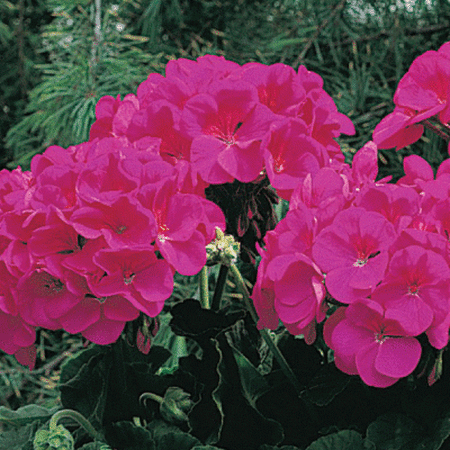Violet Maverick, Geranium Seeds
Key Attributes
Key Attributes
Product Details
Weight
0.008Depth
0.1Height
4.5Width
3.25Plant Height
12-30"Botanical Name
PelargoniumSeed Type
SeedPacket
10 SeedsSow Depth
1/8"Breed
Open-pollinatedSun
Full SunGrowing Conditions
Container FriendlyLife Cycle
AnnualSow Method
TransplantCategories
FlowersDays To Maturity (# Days)
95Components
Growing Instructions
![]() Learning Download: How to Grow Geraniums
Learning Download: How to Grow Geraniums
Geraniums are some of the most popular flowers to grow. The flowers are easy to start from seed and grow well in containers. Geraniums are also a popular choice for hanging pots.
Before Planting: The seeds have a tough outer shell, so it aids in germination to soak them before sowing. Spread the seeds over one half of a dampened paper towel and fold the paper towel in half. Put the towel-soaked seeds in a plastic bag for 24 hours prior to planting.
Planting: Once Geraniums have three sets of leaves, transplant them outdoors if the last frost date has passed.
Watering: Allow soil to go completely dry between watering.
Fertilizer: Once the Geraniums have three true sets of leaves, continue to fertilize with a water-soluble fertilizer but change it to full strength.
Days to Maturity: Geraniums will take up to 16 weeks to bloom after planting them from seed.
Harvesting: Using a knife, cut the stem four inches below its tip. Remove the buds and most of the leaves. Roll the cutting in a newspaper and store in a cool, dark place for 24 hours. After, push the end of the stem into moist soil and store in a shady spot for two days. Then, give the cutting indirect light.
Tips: During the winter, Geraniums can be moved indoors if kept in a sunny area.
Shipping Schedule
Our Seed Promise
 "Agriculture and seeds" provide the basis upon which our lives depend. We must protect this foundation as a safe and genetically stable source for future generations. For the benefit of all farmers, gardeners and consumers who want an alternative, we pledge that we do not knowingly buy or sell genetically engineered seeds or plants.
"Agriculture and seeds" provide the basis upon which our lives depend. We must protect this foundation as a safe and genetically stable source for future generations. For the benefit of all farmers, gardeners and consumers who want an alternative, we pledge that we do not knowingly buy or sell genetically engineered seeds or plants.
The mechanical transfer of genetic material outside of natural reproductive methods and between genera, families or kingdoms, poses great biological risks as well as economic, political, and cultural threats. We feel that genetically engineered varieties have been insufficiently tested prior to public release. More research and testing is necessary to further assess the potential risks of genetically engineered seeds. Further, we wish to support agricultural progress that leads to healthier soils, to genetically diverse agricultural ecosystems, and ultimately to healthy people and communities.
To learn more about the "Safe Seed Pledge" please visit www.councilforresponsiblegenetics.org.

